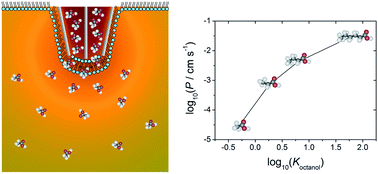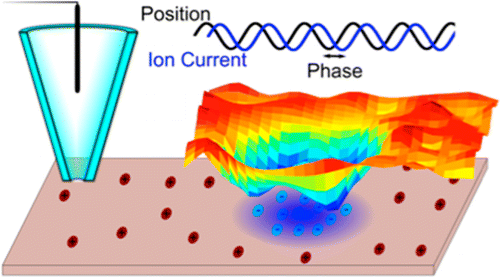Publications RSS
• Nucleation, aggregative growth and detachment of metal nanoparticles during electrodeposition at electrode surfaces, Chemical Science, 2014
The nucleation and growth of metal nanoparticles (NPs) on surfaces is of considerable interest with regard to creating functional interfaces with myriad applications. Yet, key features of these processes remain elusive and are undergoing revision. Here, the mechanism of the electrodeposition of silver on basal plane highly oriented pyrolytic graphite (HOPG) is investigated as a model system on a wide range of length scales, spanning electrochemical measurements from the macroscale to the nanoscale using scanning electrochemical cell microscopy (SECCM), a pipette-based approach. The macroscale measurements show that the nucleation process cannot be modelled as either truly instantaneous or progressive, and that step edge sites of HOPG do not play a dominant role in nucleation events compared to the HOPG basal plane, as has been widely proposed. Moreover, nucleation numbers extracted from electrochemical analysis do not match those determined by atomic force microscopy (AFM). The high time and spatial resolution of the nanoscale pipette set-up reveals individual nucleation and growth events at the graphite basal surface that are resolved and analysed in detail. Based on these results, corroborated with complementary microscopy measurements, we propose that a nucleation-aggregative growth-detachment mechanism is an important feature of the electrodeposition of silver NPs on HOPG. These findings have major implications for NP electrodeposition and for understanding electrochemical processes at graphitic materials generally.
• A new approach for the fabrication of microscale lipid bilayers at glass pipets: application to quantitative passive permeation visualization, Soft Matter, 2014
A new method of planar bilayer lipid membrane (BLM) formation is presented that allows stable, solvent-free lipid bilayers exhibiting high seal resistances to be formed rapidly, easily and reproducibly. Using these bilayers the passive permeation of a series of carboxylic acids is investigated, to determine quantitatively the trend in permeability with lipophilicity of the acid. BLMs are formed at the tip openings of pulled theta pipets, and the rate of permeation of each carboxylic acid across the bilayer, from within the pipet into the bulk solution is determined. This is achieved through spatially-resolved measurements of the pH change that occurs upon the permeation of the weak acid, visualized using a pH-sensitive fluorophore with a confocal laser scanning microscope. The extracted fluorescence profiles are matched to finite element method (FEM) simulations, to allow the associated permeation coefficient for each weak acid to be determined with high accuracy, since this is the only adjustable parameter used to fit the experimental data. For bilayers formed in this way, the weak acids show increasing permeability with lipophilicity. Furthermore, the arrangement allows the effect of a trans-membrane electric field on permeation to be explored. For both propanoic and hexanoic acid it is found that an applied electric field enhances molecular transport, which is attributed to the formation of pores within the membrane.

• Surface Charge Mapping with a Nanopipette, J. Am. Chem. Soc., 2014
Nanopipettes are emerging as simple but powerful tools for probing chemistry at the nanoscale. In this contribution the use of nanopipettes for simultaneous surface charge mapping and topographical imaging is demonstrated, using a scanning ion conductance microscopy (SICM) format. When a nanopipette is positioned close to a surface in electrolyte solution, the direct ion current (DC), driven by an applied bias between a quasi-reference counter electrode (QRCE) in the nanopipette and a second QRCE in the bulk solution, is sensitive to surface charge. The charge sensitivity arises because the diffuse double layers at the nanopipette and the surface interact, creating a perm-selective region which becomes increasingly significant at low ionic strengths (10 mM 1:1 aqueous electrolyte herein). This leads to a polarity-dependent ion current and surface-induced rectification as the bias is varied. Using distance-modulated SICM, which induces an alternating ion current component (AC) by periodically modulating the distance between the nanopipette and the surface, the effect of surface charge on the DC and AC is explored and rationalized. The impact of surface charge on the AC phase (with respect to the driving sinusoidal signal) is highlighted in particular; this quantity shows a shift that is highly sensitive to interfacial charge and provides the basis for visualizing charge simultaneously with topography. The studies herein highlight the use of nanopipettes for functional imaging with applications from cell biology to materials characterization where understanding surface charge is of key importance. They also provide a framework for the design of SICM experiments, which may be convoluted by topographical and surface charge effects, especially for small nanopipettes.

• In-situ Optimization of pH for Parts-Per-Billion Electrochemical Detection of Dissolved Hydrogen Sulfide Using Boron Doped Diamond Flow Electrodes, Anal. Chem., 2014
A novel electrochemical approach to the direct detection of hydrogen sulfide (H2S), in aqueous solutions, covering a wide pH range (acid to alkali), is described. In brief, a dual band electrode device is employed, in a hydrodynamic flow cell, where the upstream electrode is used to controllably generate hydroxide ions (OH-), which flood the downstream detector electrode and provide the correct pH environment for complete conversion of H2S to the electrochemically detectable, sulfide (HS-) ion. All-diamond, co-planar conducting diamond band electrodes, insulated in diamond, were used due to their exceptional stability and robustness when applying extreme potentials; essential attributes for both local OH- generation via the reduction of water and for in-situ cleaning of the electrode, post oxidation of sulfide. Using a galvanostatic approach, it was demonstrated the pH locally could be modified by over five pH units, depending on the initial pH of the mobile phase and the applied current. Electrochemical detection limits of 13.6 ppb sulfide were achieved using flow injection amperometry. This approach which offers local control of the pH of the detector electrode in a solution which is far from ideal for optimized detection of the analyte of interest, enhances the capabilities of on-line electrochemical detection systems.
• Positionable Vertical Microfluidic Cell Based on Electromigration in a Theta Pipet, Langmuir, 2014
A microscale vertical fluidic cell system has been implemented, based on a simple theta pipet pulled to a sharp point (ca. 10–20 μm diameter for the studies herein) and positioned with a high degree of control on a surface. The dual channel arrangement allows an electric field to be generated between an electrode in each compartment of the pipet that can be used to control the electromigration of charged species between the two compartments, across a thin liquid meniscus in contact with the substrate of interest. By visualizing the interfacial region using laser scanning confocal microscopy, the adsorption of fluorescently-labeled materials on surfaces is monitored quantitatively in real time, exemplified through studies of the adsorption of anionic microparticles (1.1 μm diameter) on positively and negatively charged substrate surfaces of poly-l-lysine (PLL) and poly-l-glutamic acid (PGA), respectively, on glass. These studies highlight significant electrostatic effects on adsorption rates and also that the adsorption of these particles is dominated by the three phase meniscus/solid/air boundary. The technique is easily modified to the case of a submerged substrate, resulting in a much larger deposition area. Finite element method modeling is used to calculate local electric field strengths that are used to understand surface deposition patterns. To demonstrate the applicability of the technique to live biological substrates, the delivery of fluorescent particles directly to the surface of a single root hair cell of Zea mays is demonstrated. The mobile pipet allows deposition to be directed to specific regions of the cell, allowing discrete sites to be labeled with particles. Finally, the technique is used to study the uptake of fluorescent polymer molecules to single root hair cells, with quantitative analysis of the adsorption rates of vinyl-sulfonic acid copolymers, with varying rhodamine B content.
• Selection, characterisation and mapping of complex electrochemical processes at individual single-walled carbon nanotubes: the case of serotonin oxidation, Faraday Discuss., 2014
The electrochemical (EC) oxidation of the neurotransmitter, serotonin, at individual single-walled carbon nanotubes (SWNTs) is investigated at high resolution using a novel platform that combines flow-aligned SWNTs with atomic force microscopy, Raman microscopy, electronic conductance measurements, individual SWNT electrochemistry and high-resolution scanning electrochemical cell microscopy (SECCM). SECCM has been used to visualise the EC activity along side-wall sections of metallic SWNTs to assess the extent to which side-walls promote the electrochemistry of this complex multi-step process. Uniform and high EC activity is observed that is consistent with significant reaction at the side-wall, rather than electrochemistry being driven by defects alone. By scanning forward and reverse (trace and retrace) over the same region of a SWNT, it is also possible to assess any blocking of EC activity by serotonin oxidation reaction products. At a physiologically relevant concentration (5 μM), there is no detectable blocking of SWNTs, which can be attributed, at least in part, to the high diffusion rate to an individual, isolated SWNT in the SECCM format. At higher serotonin concentration (2 mM), oligomer formation from oxidation products is much more significant and major blocking of the EC process is observed from line profiles recorded as the SECCM meniscus moves over an SWNT. The SECCM line profile morphology is shown to be highly diagnostic of whether blocking occurs during EC processes. The studies herein add to a growing body of evidence that various EC processes at SWNTs, from simple outer sphere redox reactions to complex multi-step processes, occur readily at pristine SWNTs. The platform described is of general applicability to various types of nanostructures and nanowires.
